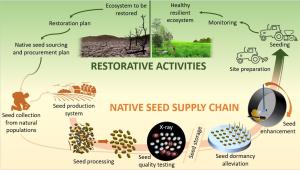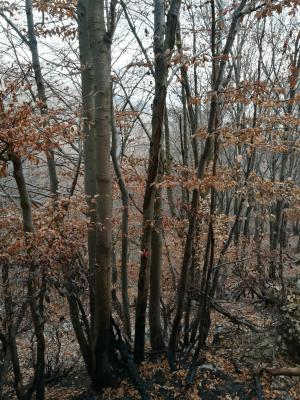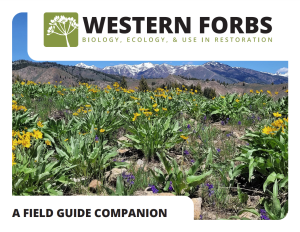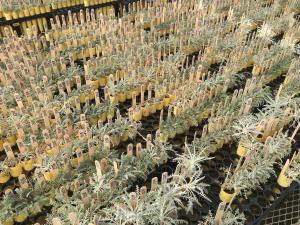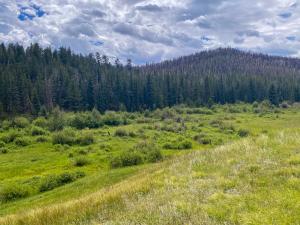Restoration and Recovery
Forests and grasslands are vulnerable to environmental stresses such as wildfire, insect infestation, diseases, invasive species, and drought. Additionally, disturbances from current or historic land uses such as energy infrastructure development, mineral development, recreation, river damming, over-grazing, and logging operations may have lasting impacts on ecosystems and ecosystem services. Often, disturbed ecosystems are slow to recover or they recover to an altered, often less desirable state. Ecological restoration aims to accelerate the recovery on an ecosystem that has been disturbed. Restoring ecosystems can help to re-establish or enhance ecosystem services including carbon sequestration, wildlife habitat, wood products, clean air and water, and opportunities for outdoor recreation and employment.
The Rocky Mountain Research Station provides cutting-edge science on restoration, reforestation, and ecosystem recovery. Our scientists led the development of the National Reforestation Strategy which in turn informed provisions in the REPLANT Act of 2021. Our research also directly informs the Native Seed Strategy.
Rocky Mountain Research Station research themes on Restoration, Reforestation, & Recovery include:
- Research & tools that support successful restoration and prioritization of restoration investments
- Development of plant materials, seed selection resources, and nursery technologies to support restoration and reforestation
- Post-fire tree and understory plant regeneration
- Post-fire recovery of watershed processes & other ecosystem services
- Using forest management treatments to restore forest structure
Read the Restoration, Reforestation & Regeneration Fact Sheet to learn more.
Featured work
- The Target Plant Concept helps managers choose plant materials and techniques that are best suited for management objectives
- Improving restoration success through a research and management partnership: A scientist-manager partnership found that locally-sourced seed will result in increased plant establishment, relative to cultivars.
- The Southern Rockies Reforestation Tool (SRRT) identifies sites that have the appropriate climate and topography to plant ponderosa pine and Douglas-fir seedings after wildfires.
Science Delivery
-
SYCU - In 5 Minutes
-
SYCU - Bulletin
-
SYCU - Bulletin
-
SYCU - Bulletin
-
SYCU - In 5 Minutes
-
SYCU - Bulletin
-
SYCU - In 5 Minutes
People
-
Person
Paula J. Fornwalt
Research Ecologist -
Person
Stephanie Yelenik
Rangeland Scientist -
Person
Alexandra K. Urza
Research Ecologist -
Person
Derek Pierson
Research Soil Scientist -
Person
-
Person
Charles (Chuck) C. Rhoades
Research Biogeochemist -
Person
Jason R. Reinhardt
Research Forester -
Person
Sarah C. Barga
Research Botanist -
Person
Brice Hanberry
Research Ecologist -
Person
Mike A. Battaglia
Research Forester -
Person
Kimberley T. Davis
Research Ecologist -
Person
Anna W. Schoettle
Research Plant Ecophysiologist -
Person
Sharon M. Hood
Research Ecologist -
Person
Robert W. Heckman
Research Botanist -
Person
Nancy L. Shaw
Scientist Emeritus -
Person
Jeanne C. Chambers
Scientist Emeritus -
Person
Justin S. Crotteau
Research Forester -
Person
Kasten Dumroese
Research Plant Physiologist / National Nursery Specialist -
Person
Elizabeth R. Milano
Research Biological Scientist -
Person
Alexander Krichels
Research Ecologist
Related Projects
-
ProjectStation
-
ProjectStation
-
ProjectStation
-
ProjectStation
-
ProjectStation
-
ProjectStation
-
ProjectStation
-
ProjectStation
-
ProjectStation
-
Center or GroupStation
-
ProjectStation
-
Center or GroupStation
-
ProjectStation
Select Publications
- Ariel B. Demarest, Paula J. Fornwalt, Brett H. Wolk, Kyle C. Rodman, Miranda D. Redmond. 2023. Mechanical forest restoration treatments stimulate understory plants in the Colorado Front Range
- Laura A. E. Marshall, Paula J. Fornwalt, Camille S. Stevens‑Rumann, Kyle C. Rodman, Charles C. Rhoades, Kevin Zimlinghaus, Teresa B. Chapman, Catherine A. Schloegel. 2023. North‑facing aspects, shade objects, and microtopographic depressions promote the survival and growth of tree seedlings planted after wildfire
- Elizabeth A. Leger, Sarah Barga, Alison C. Agneray, Owen Baughman, Robert Burton, Mark Williams. 2020. Selecting native plants for restoration using rapid screening for adaptive traits: Methods and outcomes in a Great Basin case study
- Kimberley T. Davis, Marcos D. Robles, Kerry B. Kemp, Philip E. Higuera, Teresa Chapman, Kerry L. Metlen, Jamie L. Peeler, Kyle C. Rodman, Travis Woolley, Robert N. Addington, Brian J. Buma, C. Alina Cansler, Michael J. Case, Brandon M. Collins, Jonathan D. Coop, Solomon Z. Dobrowski, Nathan S. Gill, Collin Haffey, Lucas B. Harris, Brian J. Harvey, Ryan D. Haugo, Matthew D. Hurteau, Dominik Kulakowski, Caitlin E. Littlefield, Lisa A. McCauley, Nicholas Povak, Kristen L. Shive, Edward Smith, Jens T. Stevens, Camille S. Stevens-Rumann, lan H. Taylor, Alan J. Tepley, Derek J. N. Young, Robert A. Andrus, Mike A. Battaglia, Julia K. Berkey, Sebastian U. Busby, Amanda R. Carlson, Marin E. Chambers, Erich Kyle Dodson, Daniel C. Donato, William M. Downing, Paula J. Fornwalt, Joshua S. Halofsky, Ashley Hoffman, Andres Holz, Jose M. Iniguez, Meg A. Krawchuk, Mark R. Kreider, Andrew J. Larson, Garrett W. Meigs, John Paul Roccaforte, Monica T. Rother, Hugh Safford, Michael Schaedel, Jason S. Sibold, Megan P. Singleton, Monica G. Turner, Alexandra K. Urza, Kyra D. Clark-Wolf, Larissa Yocom, Joseph B. Fontaine, John L. Campbell. 2023. Reduced fire severity offers near-term buffer to climate-driven declines in conifer resilience across the western United States
- Paula J. Fornwalt, Monique E. Rocca, Michael Battaglia, Charles C. Rhoades, Michael G. Ryan. 2017. Mulching fuels treatments promote understory plant communities in three Colorado, USA, coniferous forest types
- R. Kasten Dumroese, Deborah S. Page-Dumroese, Jeremiah R. Pinto. 2020. Biochar potential to enhance forest resilience, seedling quality, and nursery efficiency
- John A. Stanturf, Vladan Ivetic, R. Kasten Dumroese. 2024. Framing recent advances in assisted migration of Trees: A Special Issue
- Jeffrey E. Ott, Francis F. Kilkenny, Daniel D. Summers, Tyler W. Thompson, Steven L. Petersen. 2022. Post-fire succession of seeding treatments in relation to reference communities in the Great Basin
- Jeremiah R. Pinto, Joshua L. Sloan, Gokhan Ervan, Owen T. Burney. 2023. Physiological and morphological responses of Pinus ponderosa seedlings to moisture limitations in the nursery and their implications for restoration
- Sarah C. Barga, Peggy Olwell, Fred Edwards, Leah Prescott, Elizabeth A. Leger. 2020. Seeds of Success: A conservation and restoration investment in the future of U.S. lands
- Sarah C. Barga, Francis F. Kilkenny, Scott Jensen, Sarah M. Kulpa, Alison C. Agneray, Elizabeth A. Leger. 2023. Not all seed transfer zones are created equal: Using fire history to identify seed needs in the Cold Deserts of the western United States
- Carlos Rodriguez-Franco, Deborah S. Page-Dumroese. 2021. Woody biochar potential for abandoned mine land restoration in the U.S.: a review
- Kyle Rodman, Paula Fornwalt, Teresa Chapman, Jonathan Coop, Gloria Edwards, Jens Stevens, Thomas Veblen. 2022. SRRT: A decision support tool to inform postfire reforestation of ponderosa pine and Douglas-fir in the southern Rocky Mountains
- Zachary A. Holden, Dallen Warren, Kim Davis, Ellen Jungck, Marco Maneta, Solomon Dobrowski, Vince Archer. 2022. REGEN MAPPER: A web-based tool for predicting postfire conifer regeneration and prioritizing reforestation efforts in the western United States







